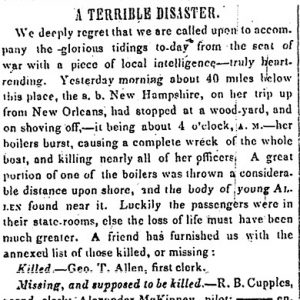calsfoundation@cals.org
New Hampshire [Steamboat]
The New Hampshire was a steamboat that suffered twelve fatalities when its boilers exploded on the Arkansas River below Little Rock (Pulaski County) in the early morning hours of May 6, 1847.
The principal owners of the New Hampshire were William Harvey Allen, who was the captain, and his younger brother George, who was first clerk. An old family friend, Robert B. Cupples, was second clerk on the New Hampshire. The steamboat ran a route between Little Rock and New Orleans, Louisiana, and boasted of being “new, with good accommodations for passengers, and from her light draught, affords better facilities for shippers having their goods delivered without delay, than any boat in the trade.”
The vessel was steaming up the Arkansas toward Little Rock after leaving New Orleans when it stopped at a wood yard about forty miles below Little Rock for fuel at around 4:00 a.m. on May 6, 1847. As the New Hampshire pulled back into the current, pilot Alex McKinney realized that there was not sufficient steam to steer the boat, so he requested that the boilers be fired up. Captain Allen, however, ordered the engines stopped as the New Hampshire slowly maneuvered its way through a snag-filled bend in the river.
Once the steamboat was far enough into the current, Allen instructed McKinney to start the engines.
The engines made a loud bang, leading a passenger to say they must have hit a snag, and then the boilers exploded, killing several crew members and two passengers. The hurricane deck and cabin tore free from the hull, which rolled over and drifted to the shore. The deck floated a mile and half before the survivors were able to tie it to the shore.
A portion of a boiler was thrown ashore, and young George Allen’s body was found nearby; he had been asleep when the boilers blew up, and his bed was found in the branches of a tree. An iron safe flew “a distance of some hundred yards” and shattered, scattering $3,000 in half-eagle coins, many of which were destroyed by the impact. Cupples and McKinney were also among the twelve deaths of the New Hampshire disaster.
Another steamboat, the Hatchee Planter, came across the wreckage of the New Hampshire and took the survivors aboard, transporting them to Little Rock. Captain Allen buried his brother in Mount Holly Cemetery and, after learning that Cupples had been buried on the shore where his body was found, had Cupples disinterred and reburied next to George Allen. The Arkansas Gazette reported that “the explosion of the boilers is said to have been caused by an accumulation of mud in them…which had become encrusted at the bottom, and prevented the water from having its usual effect.”
The New Hampshire catastrophe is one of many examples of the dangers of steamboat travel in Arkansas waters in the nineteenth century, with boiler explosions also causing mass casualties on the Car of Commerce in 1828, Rob Roy in 1836, Persian in 1840, St. Joseph in 1850, J. Wilson in 1853, Sultana in 1865, and Miami in 1866.
For additional information:
“A Terrible Disaster.” Weekly Arkansas Gazette, May 8, 1847, p. 2.
“Back Again. The Steamer NEW HAMPSHIRE, Capt. Wm. H. Allen.” [Advertisement], Weekly Arkansas Gazette, March 20, 1847, p 1.
Lloyd, James T. Lloyd’s Steamboat Directory and Disasters on the Western Waters. Cincinnati, OH: James T. Lloyd & Co., 1856, p. 294.
Ross, Margaret. “Explosion of Steamboat New Hampshire Is One of State’s Worst River Accidents.” Arkansas Gazette, December 12, 1965, p. 6E.
Mark K. Christ
Central Arkansas Library System
 Louisiana Purchase through Early Statehood, 1803 through 1860
Louisiana Purchase through Early Statehood, 1803 through 1860 Transportation
Transportation New Hampshire Steamboat Ad
New Hampshire Steamboat Ad  New Hampshire Steamboat Article
New Hampshire Steamboat Article 



Comments
No comments on this entry yet.